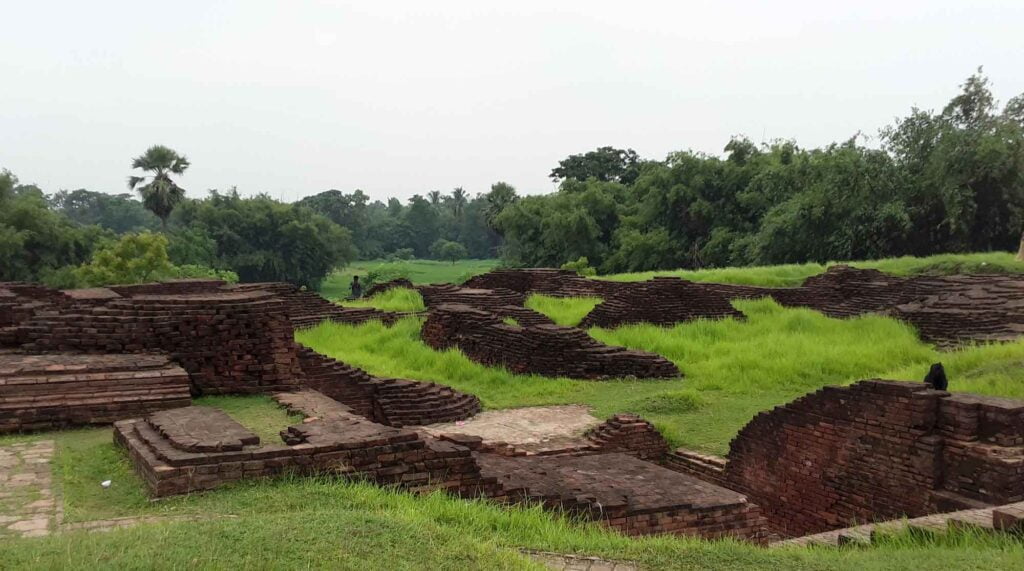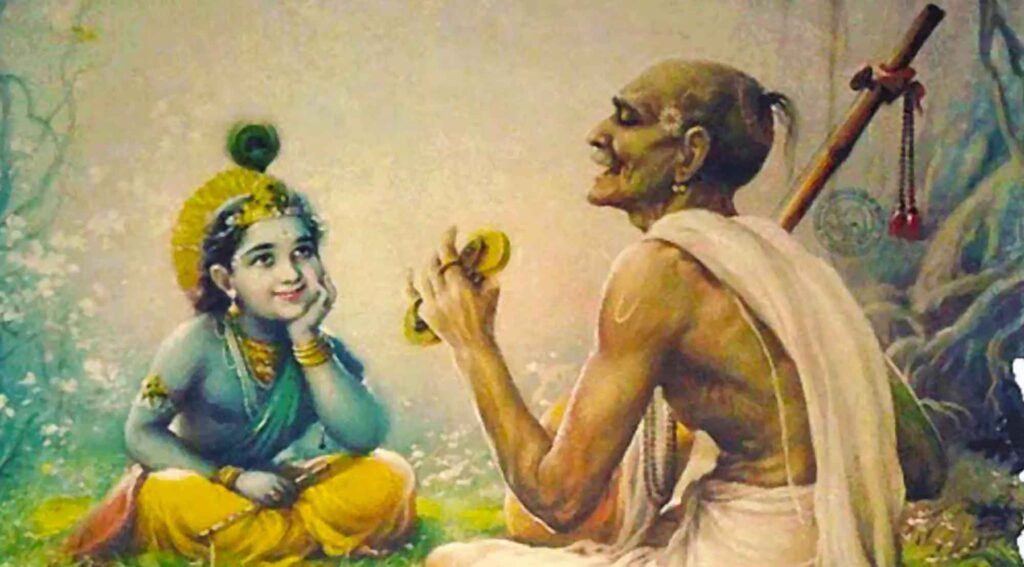Overview
Śridhāma Navadvīpera Puratana Gañja (Puratana Gañja of Śrīdhāma Navadvīpa) was first published in Sajjana Toṣaṇī Vol. 7 issue 4 in 1895. Continuing from the previous two articles about the location of Kuliyā in Navasvīpa, Bhaktivinoda Ṭhākura now turns his attention to the location of the real Śrīvāsa-aṅgana.
(translated by Swami B.V. Giri)
The place on the banks of Kuliyā where Śrīvāsa-aṅgana rose from a few years ago is called by the locals as Puratana-Gañja (‘the old village’). Recently Puratana-Gañja has fallen on the west bank of the Gaṅgā. In the time of Śrīman Mahāprabhu, the land of the old village was on the east bank of the Gaṅgā. The survey maps show the trace of the ancient flow of the Gaṅgā. On the other side of that route are places like Mātāpura, Māugāchhi, Jānnagara, Vidyānagara, Śrīrāmapura etc. Following the marks of the old course, the sand-banks of the Gaṅgā can be seen in the middle of two places – Puratana-Gañja and Nahlāpāḍā in present day Navadvīpa. It is not difficult to comprehend anything if it is understood that, at that time, it was within the waters of the Gaṅgā. If the route of the old course is drawn from Mātāpura, it would have to be taken to Gaṅgānagara, which is now attached to the Gaṅgā. Going a little east from Gaṅgānagara again, the Gaṅgā touched Māyāpura at that time, and then turned southwards in a south-westerly direction, moving towards Gādigāchā. Judging by the speed of the Gaṅgā, the shape of Prācīna Navadvīpa is fixed. From the motion of the Ganges as depicted in the maps, it will be clear that the land of Prācīna Navadvīpa is shaped like a turtle. To its north are Śrī Māyāpura, Ballal-Dighī, Brāhmaṇa Puṣkariṇī, the ancient Bilva Puṣkariṇī and Tāranavāsa (which was then Simuliya); All these villages can be seen. In the south were Becchapara, Ātappura, Bhāruibheṅgā, Nidayā, Gaṅgānagara, Puratana Gañja and Devanera Gañja. As the Gaṅgā gradually descended to Gaṅgānagara, destroying several villages in the south, the southern part of the Gaṅgā became sandy and merged with the villages on the west bank of the Gaṅgā at that time. These villagers were, in fact, the residents of their own Navadvīpa. Many of them took refuge in the village of the adjoining western bank. At that time, most of the land of Kuliyā-grāma became known as Navadvīpa because it became the home of the people of Navadvīpa. As the Gaṅgā gradually became habitable land in that Navadvīpa, Puratana-Gañja emerged as a self-contained settlement there. In Puratana-Gañja , the people of Navadvīpa came and started setting up houses, gateways and shops again. At that time, the Vaiṣṇavas created Śrīvāsa-aṅgana there. That Śrīvāsa-aṅgana gradually moved further away from the Gaṅgā and went to the banks of Kuliyā for thirty or forty years. Due to the proximity of the Gaṅgā on the banks of Kuliyā, the people of Puratana-Gañja gradually took refuge at Kuliyā in Navadvīpa.
It is necessary to consider where the Śrīvāsa-aṅgana in Puratana-Gañja came from. The original Śrīvāsa-aṅgana was near to Kholabhāṅga-ḍeṅgā in Śrī Māyāpura. We will show this later with ample evidence. There is plenty of evidence that Śrīvāsa Paṇḍita abandoned his home and settled in Kumārahatta a few days after the sannyāsa of Śrīman Mahāprabhu. Also, after the disappearance of Śrī Viṣṇupriyā Mātā, the house of Śrī Jagannātha Miśra was abandoned in Śrī Māyāpura. There is also a lot of evidence that Śrīla Prabhu Vaṁśīvadanānanda Ṭhākura took the Deity of Śrīmatī Viṣṇupriyā to his home in Kuliyā-grāma. The brāhmaṇa-paṇḍitas who lived in Śrī Māyāpura were relocated for a number of reasons. We will discuss all the reasons step by step. After all the līlā–sthānas were abandoned in this way for a long time, sorrow arose within the minds of the Vaiṣṇavas. They established Vairagi-ḍeṅgā, Śrīvāsa-aṅgana etc. in various places with the hope that they would be able to live happily in any place on the Gaṅgā at their Navadvīpa. During the reign of Dewan Ganga-Govinda Singh, many people came from Puratana-Gañja and Kuliyā and settled in the village of Rāmacandrapur built by him. At that time, Rāmacandrapura was established on the eastern bank of the river as far as the Gaṅgā had previously come. Now that land is engulfed by sand on the west side of the Gaṅgā. The signs of a temple etc. made by Singh Mahāśaya can still be seen in the sand. When Rāmacandrapura collapsed, the renunciants went to the well-to-do settlements on the west bank of the Gaṅgā and established Śrīvāsa-aṅgana etc. As the Gaṅgā receded further from Puratana-Gañja, the renunciants took shelter of Kuliyā. We have written about all these things in this article and have gathered together whatever evidence was in our hands. We will publish whatever is required. We have ascertained the place of Śrīpāṭa Kuliyā in a previous article. In this article we have said the same thing about Puratana-Gañja. I will talk more about the establishment of Navadvīpa in the next article.
We urge the readers to read the previous two essays carefully and to see with their own eyes all the areas of Kuliyā-grāma and the old route of the Gaṅgā that reaches Puratana-Gañja, and to observe the mysteries of Śrī Navadvīpa Dhāma. Take a look at that, and come and take darśana of Śrī Gaurāṅga-Viṣṇupriyā in Śrī Māyāpura. By looking at these places with an impartial mood, and properly deliberating upon our articles, you will ascertain all these places. I will say no more here at this time.













